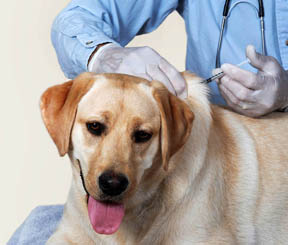
Photo courtesy of BigStock
“Oh, you don't need to drug him, Doc.”
I’ve never understood why so many clients object to tranquilization or general anesthesia for medical procedures for their animals. Do they foresee dogs on acid trips? Horses with bongs? Cockatoos on crack?
Is it a cost thing? Do folks picture little vials of injectable platinum?
Or is the objection – and I think this is probably the most likely – fear of the unknown?
I can empathize with most of these. Well, not so much tranquilization as a gateway to a drug-addled pet, but I understand cost concerns and fear.
But did anyone ask the pets?
Think about it. If you didn’t have the language skills to understand why it is in your best interests to sit still in the dentist’s chair, or hold your leg “just so” for the x-ray, or that it’s a bad idea to suddenly jump when someone is sewing up a cut on your eyelid, wouldn’t you want the drugs? The good ones?
For many animals, even being examined by a stranger is scary and stressful. If that stranger is going to poke, cut, or contort the patient into weird Twister configurations, that stress can mimic Godzilla on a day trip through the Japanese countryside.
Let’s look at the money first; I know that’s the elephant tromping through the living room. To a certain extent, veterinary practice profits are similar to restaurants; they hinge on turnover. We don’t generally make much money off things that add time to the procedure. Sedation is one of those. For instance, if I go to a ranch and sedate a horse for dentistry, I have to wait for the sedation to kick in and make sure the horse is fully recovered before I leave. The sedation fee was usually somewhere between 10 to 20% of the total cost. Not a lot in the grand scheme of things. However, in the long run, it is often easier on the pocketbook to approve sedation or anesthesia so that the job can be done properly the first time.
So, why sedate the horse, cockatoo, or wallaby?
For the most part, it comes back to asking the animal. Sedation makes stressful and potentially painful or uncomfortable procedures less uncomfortable and scary. Also, it’s much easier to do a good job of any procedure when your patient isn’t biting off bits of your technicians or dragging the assistant across five pastures.
What do I mean by “do a good job”?
Let’s go back to the dentistry example. There are folks who will tell you they can do a “good job” cleaning dog teeth or floating a horse’s teeth without sedation/anesthesia. I am going to call Bovine Excrement on that one. It. Can’t. Be. Done.
Can you make the outsides of the teeth look prettier? Sure.
Can you knock some sharp points off the horse’s teeth? Yep.
Can you make the dog’s breath smell better? Most likely.
Will you cause stress to even the best behaved animal? Definitely.
Can you perform a thorough examination of the entire mouth? Nope.
Will you miss significant dental disease and damage? Yep.
Are you likely to injure yourself, the patient, and technicians? Yes indeedy.
I’m sure I’ll get some nasty-grams for this, but those points don’t add up to “good job.” They add up to barely adequate at best and a bloody, incompetent mess at worst.
The same thing applies to X-rays. X-rays can be a great diagnostic tool, but only if they are good enough to actually be interpreted.
When my youngest child was about four, she was the flower girl for my sister’s wedding. The poor photographer nearly ran screaming off into the snowy forest because Sierra would not stay still and smile. He couldn’t get a shot.
Animals about to get an X-ray are even worse than a mischievous urchin who won’t keep her tongue in her mouth. They squirm, they wriggle, they stomp; they won’t just relax and let their legs flop into the necessary positions. Even the best behaved dogs have too much muscle tension when awake to enable the technicians to get the views needed to assess joints like hips. And if they are in pain - say they've been hit by a car - the positioning needed to diagnose fractures or other trauma will exacerbate that pain.
Even if you manage to take the X-rays on the awake animal, many times you won’t get the detail you need to interpret them.
The same thing goes for almost any procedure that is likely to cause your animal pain or fear. From removing that “tiny lump” to checking if your horse is ready to be bred, quite often it’s faster, easier on the pet, and much better from a diagnostic standpoint to just say yes to drugs from the start. As a bonus, fences, walls, clothing, and innocent bystanders remain intact.
1 Comment
Holly
August 31, 2015